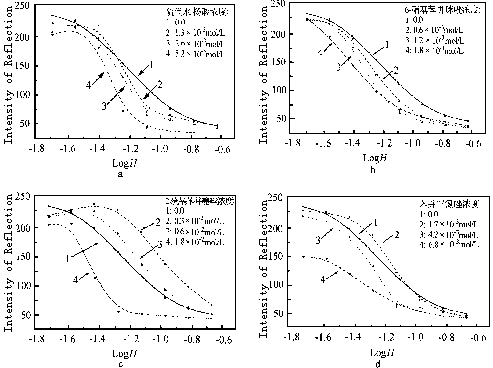When the other chemical components in the developer are not changed, the inhibitor is added with thiosalicylic acid, 6-nitrobenzimidazole, 2-mercaptobenzothiazole, and benzotriazole, and the physical silver characteristic curve obtained is obtained. See Figure 4. Figure 4 Effect of different inhibitors on the characteristic curve a: thiosalicylic acid; b: 6-nitrobenzimidazole; c: 2-mercaptobenzothiazole; d: benzotriazole; e: sulfur Salicylic acid+6 nitrobenzimidazole


Figure 4a shows the effect of thiosalicylic acid on the physical development of silver. It can be seen from the figure that as the concentration of thiosalicylic acid increases, the suppression of the physical development of the silver density in the strongly exposed areas is also shown. Stronger and stronger, and less impact on the weak exposure area. Therefore, the intermediate transition level is reduced from the original 6 to 7 grades to only 2 to 3 grades, and the slope of the photosensitive characteristic curve is continuously increased, and the contrast is significantly improved. The effect of benzobenzazole is similar to that of thiosalicylic acid, and the contrast of the plate can be increased at low concentrations (Fig. 4b). However, when the concentration of imidazole is large, weak exposure is due to its strong inhibitory effect. The level of physical development silver density is reduced, so the contrast is reduced.
The effect of 2-mercaptobenzothiazole on physical development of silver is different from that of the first two inhibitors. At low concentrations, it not only has no inhibitory effect on the physical development of silver, but rather increases the density of physical development silver (Figure 4c). Medium curve 2, 3). When the concentration is increased, the physical development of the non-exposed areas is suppressed, but the reflected light intensity of the exposed areas is reduced more. At this time, the inhibitor shows a significant effect of increasing the contrast (Fig. 4c. Curve 4). Benzotriazole has a weak contrast-enhancement effect at low concentrations (Fig. 4d). When the concentration is increased, the physical development silver, especially the weakly exposed areas of the physical development silver, is strongly affected. Inhibition greatly reduces the contrast and is not a suitable contrast promoter. The above results show that different inhibitors have different effects on plate contrast. Thiosalicylic acid has a significant increase in a wide range of concentrations. Contrast effect, 6 nitrobenzimidazole, benzotriazole only enhance the contrast effect at low concentrations, while 2 mercaptobenzothiazole at high concentrations only have this effect. This may be related to their physical development process Different inhibitory behavior and other factors The result is that when thiosalicylic acid is used in combination with 6-nitrobenzimidazole, it has an ultra-high contrast effect. Figure 4e shows that when the concentration of 6-nitrobenzimidazole is 1.2×10-3 mol/L, The change of the photosensitive characteristic curve caused by the addition of thiosalicylic acid is shown. From the figure, it can be seen that when the concentration of thiosalicylic acid is 6.4×10 −3 mol/L, only the white physical development of the weakly exposed area in the plate material is obtained. The black chemically developed silver in the silver and strongly exposed areas disappeared in the intermediate transition stage (curve 3 in Figure 4 e). The effect of increasing the contrast was higher than that of the two inhibitors alone. This result has not been seen in the literature. Report. (To be continued)